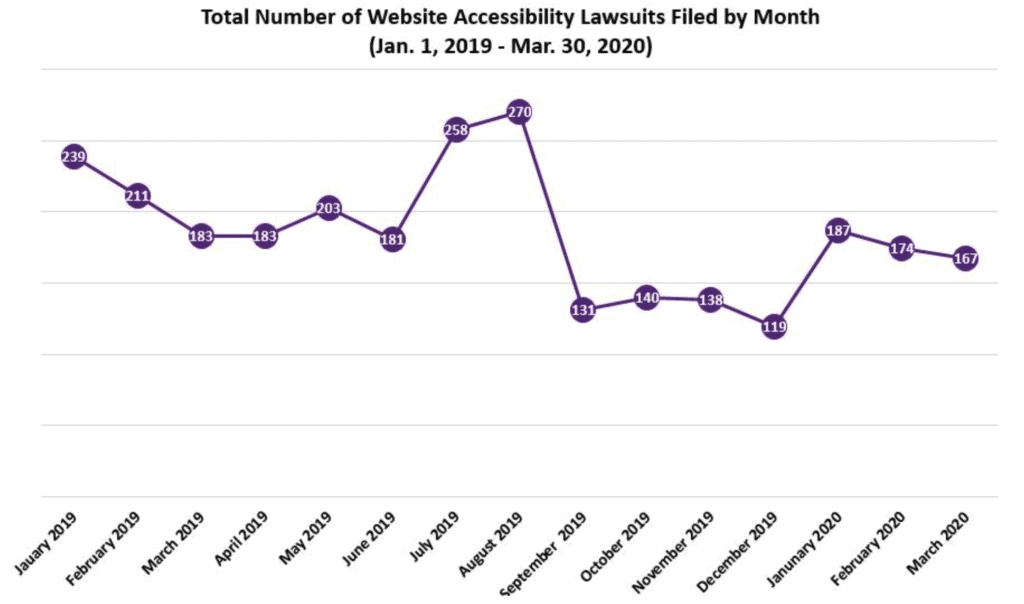Did you know that web accessibility lawsuits are filed at an alarming rate of 1 every working hour?
Yes! And you could be next!
I am sure it’s no news to you that a web accessibility lawsuit can completely tarnish your brand’s reputation and lead to a massive drop in your website traffic.
Brands such as Netflix, Target, Tesco, and Disney have been hit by these lawsuits before and have suffered substantial financial losses due to it.
Be it travel, real estate, entertainment, retail, or any other industry, none are likely to be spared.
Hence, it is crucial for businesses like yours to get educated about and adopt web accessibility standards. Not only will this protect you from web accessibility lawsuits, but it will also improve your UX, boost your SEO, and increase brand visibility.
Would you like to know how to avoid web accessibility lawsuits and the huge settlements that come with it? Let’s find out!
What is Web Accessibility? Why is it so important?
Around 20% of the American population are categorized as disabled. These disabilities may include visual impairment, hearing impairment, grasping difficulties, disability to handle mouse/keyboard, or even mental impairment.
Working on your website’s accessibility will ensure that people with disabilities will be able to use, understand, and navigate your website with ease.
This is why compliance to ADA (Americans with Disability Act) is of utmost importance to your website, and it’s time to take action now!
Are you at a Risk of Web Accessibility Lawsuits?
Web accessibility covers a lot of different aspects such as color contrast, usability without a mouse, alt texts for images, descriptive texts, and many more.
According to Google’s Web Accessibility guidelines, four main principles need to be kept in mind for web accessibility. These are usually called by the acronym POUR – Perceivable, Operable, Understandable, and Robust.
A form with accessibility issues
A form where accessibility issues have been fixed
If you’ve never done a web accessibility audit before or if it has been a long time since you did one, then you probably are at risk of a web accessibility lawsuit.
How to Avoid Web Accessibility Lawsuits?
Now that you know how big of a risk ignoring web accessibility standards is, there’s good news – web accessibility lawsuits are preventable! But how?
You need to prepare, plan, and design your website in such a way that it is ADA compliant.
1. Understand the Web Content Accessibility Guidelines (WCAG)
It is crucial to go through and understand the web accessibility guidelines before setting out to conduct an audit and start investing in solutions.
The WCAG provided by the World Wide Web Consortium gives you a thorough understanding of the principles and practices that need to be followed to remove all kinds of barriers for people with disabilities.
2. Invest in a web accessibility solution
Investing in good accessibility software will be the wisest marketing decision that you make for your business today.
A small investment can keep you away from losses worth thousands of dollars and spare you years worth of rebuilding your brand’s reputation.
The best ones to look out for are automated AI-based web accessibility solutions like the one provided by accessiBe. All you need to do is add a single line of code to your website, and everything else is taken care of. And the best part – it is very affordable, considering the amount of money it is going to save you in the coming years.
3. Keep taking measures to fix accessibility issues regularly
Did you know that a large percentage of companies get hit by web accessibility lawsuits multiple times?
But didn’t they get it fixed the first time around?
Web accessibility compliance is not a one-time done and dusted solution. The guidelines keep changing and your website content keeps changing too.
This is why it’s really important to keep conducting automated accessibility audits and updating your website to always stay ADA compliant.
Again, an AI-powered solution like AccessiBe can be of massive help here. It keeps analyzing and scanning your website for accessibility issues and automatically fixes them every 24 to 48 hours. You install it once, and you need not worry about it after.
5. Develop a healthy culture of accessibility and inclusivity
Remember that web accessibility compliance is a win-win situation for you and your customers.
By creating an environment of compassion towards disability and developing inclusivity, your customers will feel truly welcome.
Here are a few small measures that you can take:
- Educate yourself and everyone who is a part of your company about web accessibility and the different compliance standards.
- Consider accessibility as an essential part of all your web design planning. Remember to work with the POUR principle.
- Put up a web accessibility statement on your website to let your users know that your brand supports accessibility and inclusivity with a whole heart. This will distinguish your brand from the others, and your users are bound to come back to you again and again.
Conclusion
With one in every five people being disabled in some way, it is our social responsibility to remove all the barriers of accessibility and give full hindrance-free access to everyone who wants to interact with your brand.
And if you’re not taking up this responsibility, a web accessibility lawsuit is definitely waiting for you around the corner.
And remember that it comes with huge monetary losses and massive damage to your brand’s online reputation.
You’ve heard the saying – better safe than sorry. So, take action today, invest in a good web accessibility solution, and stay away from compliance lawsuits!



